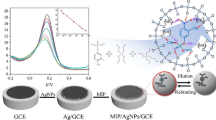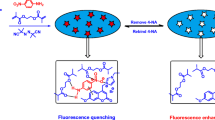Abstract
A fiber-optic evanescent wave sensor for bisphenol A (BPA) determination based on a molecularly imprinted polymer (MIP)-modified fiber column was developed. MIP film immobilized with BPA was synthesized on the fiber column, and the sensor was then constructed by inserting the optical fiber prepared into a transparent capillary. A microchannel (about 2.0 μL) formed between the fiber and the capillary acted as a flow cell. BPA can be selectively adsorbed online by the MIP film and excited to produce fluorescence by the evanescent wave produced on the fiber core surface. The conditions for BPA enrichment, elution, and fluorescence detection are discussed in detail. The analytical measurements were made at 276 nm/306 nm (λ ex/λ em), and linearity of 3 × 10−9–5 × 10−6 g mL−1 BPA, a limit of detection of 1.7 × 10−9 g mL−1 BPA (3σ), and a relative standard deviation of 2.4 % (n = 5) were obtained. The sensor selectivity and MIP binding measurement were also evaluated. The results indicated that the selectivity and sensitivity of the proposed fiber-optic sensor could be greatly improved by using MIP as a recognition and enrichment element. Further, by modification of the sensing and detection elements on the optical fiber, the proposed sensor showed the advantages of easy fabrication and low cost. The novel sensor configuration provided a platform for monitoring other species by simply changing the light source and sensing elements. The sensor presented has been successfully applied to determine BPA released from plastic products treated at different temperatures.

EW eixcation of BPA immobilized in MIP on the fiber core surface









Similar content being viewed by others
References
Yin H, Napolitano S, Schönhals A (2012) Molecular mobility and glass transition of thin films of poly(bisphenol A carbonate). Macromolecules 45:1652–1662
Tripathy R, Ojha U, Faust R (2011) Polyisobutylene modified bisphenol A diglycidyl ether based epoxy resins possessing improved mechanical properties. Macromolecules 44:6800–6809
Vandenberg LN, Colborn T, Hayes TB, Heindel JJ, Jacobs DR Jr, Lee DH, Shioda T, Soto AM, vom Saal FS, Welshons WV, Zoeller RT, Myers JP (2012) Hormones and endocrine-disrupting chemicals: low-dose effects and nonmonotonic dose responses. Endocr Rev 33:378–455
Liao C, Kannan K (2011) Widespread occurrence of bisphenol A in paper and paper products: implications for human exposure. Environ Sci Technol 45:9372–9379
Meeker JD, Calafat AM, Hauser R (2010) Urinary bisphenol A concentrations in relation to serum thyroid and reproductive hormone levels in men from an infertility clinic. Environ Sci Technol 44:1458–1463
Safe SH (2000) Endocrine disruptors and human health—is there a problem? An update. Environ Health Perspect 108:487–493
Cao XL, Corriveau J (2008) Migration of bisphenol A from polycarbonate baby and water bottles into water under severe conditions. J Agric Food Chem 56:6378–6381
Cooper JE, Kendig EL, Belcher SM (2011) Assessment of bisphenol A released from reusable plastic, aluminium and stainless steel water bottles. Chemosphere 85:943–947
Cao XL, Corriveau J, Popovic S (2009) Migration of bisphenol A from can coatings to liquid infant formula during storage at room temperature. J Food Prot 72:2571–2574
Vandenberg LN, Hauser R, Marcus M, Olea N, Welshons WV (2007) Human exposure to bisphenol A (BPA). Reprod Toxicol 24:139–177
Liao C, Kannan K (2011) High levels of bisphenol A in paper currencies from several countries, and implications for dermal exposure. Environ Sci Technol 45:6761–6768
Commission E (2004) Commission Directive 2004/19/EC of 1 March 2004 amending Directive 2002/72/EC relating to plastic materials and articles intended to come into contact with foodstuffs. Off J Eur Union L 71:8–21
Geens T, Aerts D, Berthot C, Bourguignon JP, Goeyens L, Lecomte P, Maghuin-Rogister G, Pironnet AM, Pussemier L, Scippo ML, Van Loco J, Covaci A (2012) A review of dietary and nondietary exposure to bisphenol-A. Food Chem Toxicol 50:3725–3740
Commission E (2011) Commission Directive 2011/8/EU amending Directive 2002/72/EC as regards the restriction of use of bisphenol A in plastic infant feeding bottles. Off J Eur Union L 25:11–14
US Food and Drug Administration (2012) Bisphenol A (BPA): use in food contact application. http://www.fda.gov/NewsEvents/PublicHealthFocus/ucm064437.htm. Accessed 25 Dec 2012
National Conference of State Legislatures (2012) NCSL policy update: state restrictions on bisphenol A (BPA) in consumer products. http://www.ncsl.org/issues-research/env-res/policy-update-on-state-restrictions-on-bisphenol-a.aspx. Accessed 5 Dec 2012
Mudiam MKR, Jain R, Dua VK, Singh AK, Sharma VP, Murthy RC (2011) Application of ethyl chloroformate derivatization for solid-phase microextraction-gas chromatography-mass spectrometric determination of bisphenol-A in water and milk samples. Anal Bioanal Chem 401:1699–1705
Lu J, Wu J, Stoffella PJ, Wilson PC (2012) Isotope dilution-gas chromatography/mass spectrometry method for the analysis of alkylphenols, bisphenol A, and estrogens in food crops. J Chromatogr A 1258:128–135
Yazdinezhad SR, Ballesteros-Gómez A, Lunar L, Rubio S (2013) Single-step extraction and cleanup of bisphenol A in soft drinks by hemimicellar magnetic solid phase extraction prior to liquid chromatography/tandem mass spectrometry. Anal Chim Acta 778:31–37
Salgueiro-González N, Concha-Grá E, Turnes-Carou I, Muniategui-Lorenzo S, López-Mahía P, Prada-Rodríguez D (2012) Determination of alkylphenols and bisphenol A in seawater samples by dispersive liquid-liquid microextraction and liquid chromatography tandem mass spectrometry for compliance with environmental quality standards (Directive 2008/105/EC). J Chromatogr A 1223:1–8
Liu S, Xie Q, Chen J, Sun J, He H, Zhang X (2013) Development and comparison of two dispersive liquid-liquid microextraction techniques coupled to high performance liquid chromatography for the rapid analysis of bisphenol A in edible oils. J Chromatogr A 1295:16–23
Ballesteros-Gómez A, Rubio S, Pérez-Bendito D (2009) Analytical methods for the determination of bisphenol A in food J. Chromatogr A 449:449–469
Molina-García L, Córdova MLF-d, Ruiz-Medina A (2012) Analysis of bisphenol A in milk by using a multicommuted fluorimetric sensor. Talanta 96:195–201
Maroto A, Kissingou P, Diascorn A, Benmansour B, Deschamps L, Stephan L, Cabon J-Y, Giamarchi P (2011) Direct laser photo-induced fluorescence determination of bisphenol A. Anal Bioanal Chem 401:3011–3017
Hegnerová K, Piliarik M, Šteinbachová M, Flegelová Z, Černohorská H, Homola J (2010) Detection of bisphenol A using a novel surface plasmon resonance biosensor. Anal Bioanal Chem 398:1963–1966
Mei S, Wu D, Jiang M, Lu B, Lim JM, Zhou YK, Lee YI (2011) Determination of trace bisphenol A in complex samples using selective molecularly imprinted solid-phase extraction coupled with capillary electrophoresis. Microchem J 98:150–155
Zheng Z, Du Y, Wang Z, Feng Q, Wang C (2013) Pt/graphene-CNTs nanocomposite based electrochemical sensors for the determination of endocrine disruptor bisphenol A in thermal printing papers. Analyst 138:693–701
Qu Y, Ma M, Wang Z, Zhan G, Li B, Wang X, Fang H, Zhang H, Li C (2013) Sensitive amperometric biosensor for phenolic compounds based on graphene-silk peptide/tyrosinase composite nanointerface. Biosens Bioelectron 44:85–88
Li Y, Gao Y, Cao Y, Li H (2012) Electrochemical sensor for bisphenol A determination based on MWCNT/melamine complex modified GCE. Sens Actuators B Chem 172:726–733
Sun P, Wu Y (2013) An amperometric biosensor based on human cytochrome P450 2C9 in polyacrylamide hydrogel films for bisphenol A determination. Sens Actuators B Chem 178:113–118
Portaccio M, Di Tuoro D, Arduini F, Lepore M, Mita D, Diano N, Mita L, Moscone D (2010) A thionine-modified carbon paste amperometric biosensor for catechol and bisphenol A determination. Biosens Bioelectron 25:2003–2008
Wulff G, Sarhan A, Zabrocki K (1973) Enzyme-analogue built polymers and their use for the resolution of racemates. Tetrahedron Lett 14:4329–4332
Vlatakis G, Andersson LI, Müller R, Mosbach K (1993) Drug assay using antibody mimics made by molecular imprinting. Nature 361:645–647
Piletska EV, Burns R, Terry LA, Piletsky SA (2012) Application of a molecularly imprinted polymer for the extraction of kukoamine A from potato peels. J Agric Food Chem 60:95–99
Ke Y, Zhu F, Zeng F, Luan T, Su C, Ouyang G (2013) Preparation of graphene-coated solid-phase microextraction fiber and its application on organochlorine pesticides determination. J Chromatogr A 1300:187–192
Hoshino Y, Koide H, Urakami T, Kanazawa H, Kodama T, Oku N, Shea KJ (2010) Recognition, neutralization, and clearance of target peptides in the bloodstream of living mice by molecularly imprinted polymer nanoparticles: a plastic antibody. J Am Chem Soc 132:6644–6645
Li J, Li Y, Zhang Y, Wei G (2012) Highly sensitive molecularly imprinted electrochemical sensor based on the double amplification by an inorganic Prussian blue catalytic polymer and the enzymatic effect of glucose oxidase. Anal Chem 84:1888–1893
Orozco J, Cortés A, Cheng G, Sattayasamitsathit S, Gao W, Feng X, Shen Y, Wang J (2013) Molecularly imprinted polymer-based catalytic micromotors for selective protein transport. J Am Chem Soc 135:5336–5339
Pietrzyk A, Kutner W, Chitta R, Zandler ME, Souza FD, Sannicolò F, Mussini PR (2009) Melamine acoustic chemosensor based on molecularly imprinted polymer film. Anal Chem 81:10061–10070
Hong CC, Chang PH, Lin CC, Hong CL (2010) A disposable microfluidic biochip with on-chip molecularly imprinted biosensors for optical detection of anesthetic propofol. Biosens Bioelectron 25:2058–2064
Hiratsuka Y, Funaya N, Matsunaga H, Haginaka J (2013) Preparation of magnetic molecularly imprinted polymers for bisphenol A and its analogues and their application to the assay of bisphenol A in river water. J Pharm Biomed Anal 75:180–185
Alexiadou DK, Maragou NC, Thomaidis NS, Theodoridis GA, Koupparis MA (2008) Molecularly imprinted polymers for bisphenol A for HPLC and SPE from water and milk. J Sep Sci 31:2272–2282
Wang Y, Yang Y, Xu L, Zhang J (2011) Bisphenol A sensing based on surface molecularly imprinted, ordered mesoporous silica. Electrochim Acta 56:2105–2109
Fuchs Y, Linares AV, Mayes AG, Haupt K, Soppera O (2011) Ultrathin selective molecularly imprinted polymer microdots obtained by evanescent wave photopolymerization. Chem Mater 23:3645–3651
Harrick NJ (1967) Internal reflection spectroscopy. Wiley, New York
Ge Z, Brown CW, Sun L, Yang SC (1993) Fiber-optic pH sensor based on evanescent wave absorption spectroscopy. Anal Chem 65:2335–2338
Vogt F, Karlowatz M, Jakusch M, Mizaikoff B (2003) The automated sample preparation system MixMaster for investigation of volatile organic compounds with mid-infrared evanescent wave spectroscopy. Analyst 128:397–403
Xiong Y, Zhu D, Duan C, Wang J, Guan Y (2010) Small-volume fiber-optic evanescent-wave absorption sensor for nitrite determination. Anal Bioanal Chem 396:943–948
Xiong Y, Ye Z, Xu J, Zhu Y, Chen C, Guan Y (2013) Integrated micro-volume fiber-optic sensor for oxygen determination in exhaled breath based on iridium(III) complexes immobilized in fluorinated xerogels. Analyst 138:1819–1827
Xiong Y, Huang Y, Ye Z, Guan Y (2011) Flow injection small-volume fiber-optic pH sensor based on evanescent wave excitation and fluorescence determination. J Fluoresc 21:1137–1142
Yamamoto H, Liljestrand HM (2004) Partitioning of selected estrogenic compounds between synthetic membrane vesicles and water: effects of lipid components. Environ Sci Technol 38:1139–1147
Xue J, Li D, Qu L, Long Y (2013) Surface-imprinted core-shell Au nanoparticles for selective detection of bisphenol A based on surface-enhanced Raman scattering. Anal Chim Acta 777:57–62
Acknowledgments
This work was supported by the Open Fund of the State Key Laboratory of Oil and Gas Reservoir Geology and Exploitation (Southwest Petroleum University) (grant no. PLN 1313), the Foundation of Sichuan Educational Committee (no. 14ZB0048) the School Technology Fund of Southwest Petroleum University (grant no. 2013XJZ015), SWPU Pollution Control of Oil & Gas Fields Science & Technology Innovation Youth Team (no. 2013XJZT003), and the Research Project of General Administration of Quality Supervision, Inspection and Quarantine of the People’s Republic of China (no. 2013IK168).
Author information
Authors and Affiliations
Corresponding author
Rights and permissions
About this article
Cite this article
Xiong, Y., Ye, Z., Xu, J. et al. A microvolume molecularly imprinted polymer modified fiber-optic evanescent wave sensor for bisphenol A determination. Anal Bioanal Chem 406, 2411–2420 (2014). https://doi.org/10.1007/s00216-014-7664-4
Received:
Revised:
Accepted:
Published:
Issue Date:
DOI: https://doi.org/10.1007/s00216-014-7664-4




